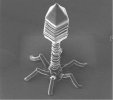If you're a Harry Potter fan, I don't need to tell you what the Imperius curse is. For the rest of you, it's a spell used to control people's minds. Now, if you thought something like this was possible only in J.K. Rowling's world, well here's some news for you. Nature's obviously one step ahead. The Jewel Wasp or 'Emerald Cockroach Wasp' is actually able to control the mind of its prey, the cockroach, by injecting venom directly into its brain.
The secret to the Jewel Wasp's 'captivating' abilities lies in a neurotransmitter called octopamine in the cockroach's brain that controls its movements. The wasp's venom blocks the octopamine, literally converting the cockroach into a zombie. This 'zombie' cockroach is completely unable to fight back as it is pulled by the wasp into its underground lair. If you're wondering why the wasp would go through all this trouble to just eat a cockroach, here's the really weird part -- the cockroach is meant to unwillingly play the part of surrogate mother. The wasp lays an egg into the cockroach's abdomen, and the larva later hatches and eats the live cockroach from inside out. It takes 3 or 4 days for the larva to hatch, after which it slowly feeds on the roach's internal organs, keeping it alive the whole time. This process takes about 7-8 days, during which the meat needs to be fresh for the larva. And because a dead cockroach rots within a day, the wasp prefers the 'stun' method. Once the roach is eaten up completely and it dies, the larva forms a cocoon inside it. A fully-grown wasp emerges from the cockroach carcass a month later.
The Jewel wasp is quite clean and precise in its injection of the venom. It starts by stinging the cockroach around its midsection. By doing this, the front legs are paralyzed. Then, the wasp proceeds to make a more precise sting, injecting the venom directly into the brain to block the octopamine. At this point, the cockroach is still able to move around and can flee if it wants to. But that's the trouble, the venom works on the roach's free will causing it to lose all motivation to run away from potential danger and pain. So now the wasp is pretty much free to coerce the cockroach into the direction of its choice by tugging and guiding its prey. And you know what happens next.
Jewel wasps are normally found in the tropical regions of Africa, India and the Pacific islands. In a single mating session, a female wasp is able to produce enough fertilized eggs to place on several dozens of cockroaches. The phenomenon is so fascinating that scientists have conducted several experiments in an attempt to understand it better. Over the course of several investigations, they've figured out that octopamine is quite similar to noradrenaline in humans, which is involved in the fight-or-flight reaction in the vertebrate brain. They found out that the wasp injects the venom into a very specific area of the roach's brain. So when researchers reversed the process by injecting an octopamine-like substance into the same part of a 'zombie' roach's brain, it resulted in significant recovery and restoration of its free will. Scientists have also observed that the Jewel wasp will sting a cockroach continuously for up to 3 minutes in order to determine the right spot, the sub-esophageal ganglia.
The Jewel wasp is one-of-a-kind, the only known parasite that injects its venom directly into its host's brain. But there are other parasites that control their prey's behavior in several ways. Makes you wonder at how amazing-yet-scary nature is, doesn't it?





